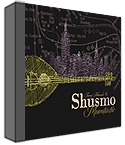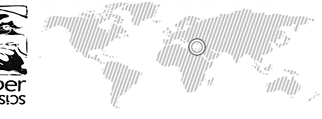“It´s a great name. And easy to remember,” comments Tareq Abboushi, explaining the alt-Arab group’s name “Shusmo”. I agree, intrigued by the fact that “shusmo”, which in Arab means “whatchamacallit”, must obviously have originated the Mexican Spanish word “chusme” with exactly the same meaning. Once again, language, much like music does so often, shares a fascinating clue as to the diverse cultures that fused and formed us as Latinos.
Shusmo’s musical fusion also brings several surprising musical elements into its compositions, adding Latin nuances as well as a dose of funk onto a classical Arab foundation. Palestinian-born Abboushi originally studied jazz piano at William Paterson in New Jersey, but moved away from jazz-based fusions and founded Shusmo in the year 2000. Speaking by phone from New York City, he explains how Shusmo’s music came to have its Latin touch: “I love all kinds of Afrolatin rhythms and went through a phase where I listened to a lot of Afrocuban music. So it inspires me when I composes…also, there’s similarities between Arabic and Latin rhythms. For example, I listen to Moroccan gnawa, and then listen to a Peruvian festejo, and I hear similarities in sound and feel and the way they are played.” He adds that the fact that the group includes Peruvian percussionist Hector Morales makes the Latin infusions even stronger.
But the bigger picture is about creating a new Arabic music, says Abboushi: “We´re looking for a sound that is an alternative to classical Arabic music and the pop that is commercially manufactured, Brittany Spears-style, that sounds the same no matter where you are from… music for a younger audience that can still bring in some of the beautiful elements of classical Arabic music, but packaged in way that younger people can listen to it and enjoy, have it at a party, and maybe even dance to it.”
Bringing together such diverse musical traditions takes creating music in a special way. In Abboushi’s music, counterpoint creates the structure where East and West coexist and create beauty. He defines for me how this works: “…it’s a style of composition write melodies that are independent by themselves. In Western music, two or notes together played at the same time, creates harmony, which has a function and pushes the song forwIard. In Arabic music, it’s melody that moves the music forward. For example, a whole orchestra may play the same melody. By using counterpoint, you can have independent melodies that intertwine with each other.”
This strikes as being at the heart of the energy that one feels in Shusmo’s music, a feeling that it would be wonderful world if we could only allow diverse traditions to each create their individually beautiful songs and contribute to an emergent new song. Abboushi agrees that music does harness a special power: “… when you are by yourself, creating or listening you can have a spiritual experience by yourself … and with people, there’s more energy to move around, to make people happy and share certain things. In the case of performance, there’s a back and forth between the performer and audience, and that brings the musician to another level. It can lift you to amazing places.”



